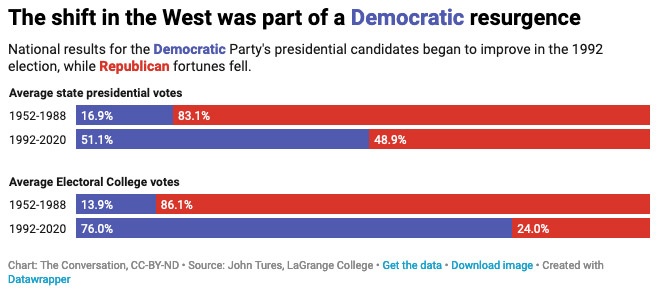This commentary is excerpted from a op-ed by John A. Tures that appeared in Colorado Newsline on December 26, 2022. It originally appeared in The Conversation.
U.S. Sen. Catherine Cortez Masto’s win in Nevada guaranteed that Democrats would retain control of the Senate after the 2022 midterm elections. It also confirmed the strength of the Democratic Party in the West.
Since 1992, Democrats have flipped the region away from Republican control, a shift that began with the end of the Cold War and carried through a Pacific Coast economic recession, anti-racism demonstrations and violence in Los Angeles and the area’s increasing diversity.
I am a professor of political science who has published on the subject of critical elections and how regional realignments in voting patterns have had an impact on presidential elections at the national level.
This shift has been particularly obvious during presidential elections. From 1952 to 1988, Republican politicians dominated the West — the 13 states of Alaska, Hawaii, Washington, Oregon, California, Arizona, Nevada, Idaho, Montana, Wyoming, Utah, Colorado and New Mexico — in presidential contests, as well as a number of statewide contests. In the presidential elections during those years, Democratic candidates took an average of just 13.9% of the Electoral College votes from those Western states. And in those elections, Democrats received an average of 46.4% of the Western popular vote.
But since 1992, Democrats have won an average of 76% of the Electoral College vote in the West through the 2020 election, with an average of 55% of the two-party vote in those 13 states from the Pacific through the Rockies. Democrats garnered 58% of the Western state vote in the 2016 and 2020 presidential elections.
The shift began in the late 1980s, with a series of post-Cold War military base closures across the nation. A president-appointed Base Realignment and Closure Commission determined which military bases should remain open and which should close, as the nation’s military needs changed. The West bore a disproportionate share, losing 48 bases, while the rest of the nation as a whole lost 120.
That was true especially in the first two rounds of closures, in 1988 and 1991, under President George H.W. Bush, a Republican. The second set of closures, in 1993 and 1995, under Democratic President Bill Clinton, still leaned heavily on the West, but not as much as the earlier rounds had.
Closing a military base has socioeconomic costs: It means an area loses jobs and revenue for local businesses, especially those that supplied the base or served its personnel or their families. There are also costs of military spouses losing their jobs, and of changes to a community’s sense of itself, often built up over decades, especially in rural areas. And this compounded the region’s economic woes, making Westerners more open to switching their votes from an “R” to a “D.”
Additional economic pressure came during the 1990-91 recession, which disproportionately hit the Pacific and Atlantic coasts, according to Mary C. Dzialo et al. The West suffered the highest levels of unemployment among all four geographic regions, and those who lost jobs or business were quick to blame Republicans, especially President George H.W. Bush, for the tough economic times.
The West was also getting more diverse, in comparison to other regions. The National Equity Atlas calculates a diversity index for each region, on a range from zero to 1.79, in which zero indicates that everyone in the area is of the same racial or ethnic group, and 1.79 indicates that equal numbers of people are in each racial or ethnic group.
A look at the index from 1980 to 2019 shows that the West has long been more diverse than the rest of the country, and significantly more so in the 1990s. The rest of the country began to catch up, but the West is still more diverse than the rest of the nation.
Non-whites have leaned Democratic in greater numbers thanks to the party’s increased focus on better treatment for minorities, as well as the open embrace of white supremacy by some members of the Republican Party.
These economic, social, demographic and political factors of the early 1990s helped contribute to the Democrats flipping the region to their column. This translated into national success for Democrats, who in the eight elections from 1992 to 2020 nearly doubled their average Electoral College votes from the 1952 to 1988 period. Meanwhile, the GOP national average of Electoral College votes declined.
Democrats have won nearly two-thirds of the national Electoral College races in the past 30 years. And the Republicans have won the popular vote just once since 1992, that being in 2004. It’s a trend likely to give Democrats an electoral advantage nationally… unless the GOP does a better job of appealing to Western voters.
John A. Tures is a Professor of Political Science, LaGrange College. Nicole Morales, a LaGrange College undergraduate student, contributed to this work.

